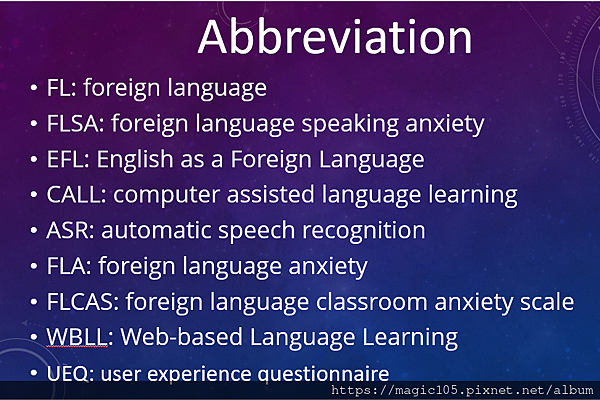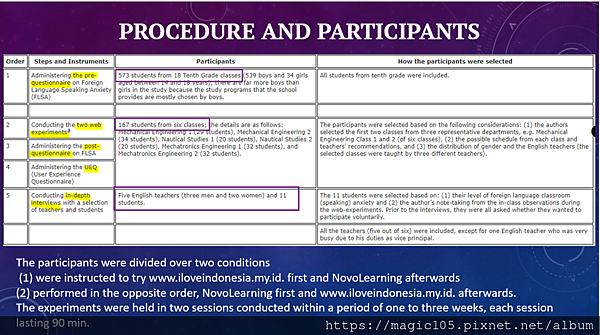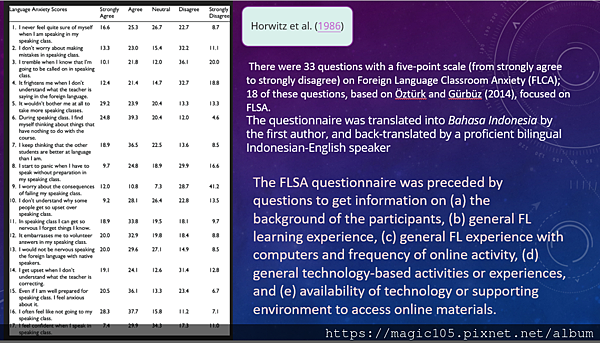這次數位華語研究是 EMI 全英語課程,所以報告也是全英文,但是英文論文沒有比較難,好感人啊~~
![]() Web-based language learning and speaking anxiety
Web-based language learning and speaking anxiety
(2022) Web-based language learning and speaking anxiety, Computer Assisted Language Learning, 35:5-6, 1058-1089, DOI: 10.1080/09588221.2020.1770293
https://www.tandfonline.com/doi/full/10.1080/09588221.2020.1770293
![]() 縮寫
縮寫
因為論文中有很多縮寫,先背一下後面才看得懂

![]() 摘要
摘要
簡單描述整個研究目的,對象,為什麼做,怎麼做,結果如何等等

結果: The results showed that students indicated a moderate-to-serious level of FLSA, that they evaluated the learning websites positively, and believed that web-based language learning could alleviate their speaking anxiety. The interviews revealed that students felt less anxious when speaking in front of the ASR-based websites compared to speaking to peers or people.
![]() 什麼是 FLSA
什麼是 FLSA
What is FLSA?
FLSA is a multifaceted psychological phenomenon that many learners experience when learning a FL. It affect language learning and to be a negative predictor of language achievement (Horwitz, Horwitz, & Cope, 1986; Teimouri, Goetze, & Plonsky, 2019)
![]() 引用非常多文獻探討
引用非常多文獻探討

How to solve the problem?
Reducing FLSA is one of the ways to help increase English proficiency in Indonesia.
Modern approaches to language learning have begun utilizing technology to create successful learning events that could reduce FLSA. CALL is considered to be an effective and promising approach in today’s and tomorrow’s language teaching and learning.

![]() 研究問題
研究問題
What level of FLSA do vocational high school students in Indonesia experience in the traditional classroom?
What is the students’ evaluation of their experience in using two speech-enabled websites (www.iloveindonesia.my.id. and NovoLearning) to practice their speaking?
What is the effect of web-based language learning on students’ FLSA?
![]() 印尼簡單介紹
印尼簡單介紹
全世界最大群島之一,人口眾多,多元種族及文化。
政府認定英語為重要溝通語言,國高中必須提供高級的學習技巧課程

![]() 引用非常多文獻探討
引用非常多文獻探討




![]() Methodology
Methodology
We employed a mixed methods research, starting from administering the pre-questionnaire on FLSA to conducting in-depth interviews with a selection of students and teachers. The data we gained from the research are a combination of quantitative and qualitative data, that we analyzed using SPSS and narrative inquiry.

![]() Instrument
Instrument
(1) the (pre- and post-) questionnaire on FLSA, (573)

(2) the User Experience Questionnaire (167)

(3) the interview guidelines, including the list of questions and the clues/prompts. (5T+11Ss)
(1) on FLSA, ten key questions for students and six key questions for teachers on FLSA as formulated by Tanveer (2007) were employed
(2) on students’ and teachers’ experience in using the learning websites to practice speaking,. the first author asked open-ended questions about web-based language learning in connection with speaking anxiety and triggered discussions about its SWOT.
The results of the interviews were transcribed and subsequently analyzed in a qualitative way.
A website called www.iloveindonesia.my.id was designed by the first author (Bashori, 2018)
The examples of speaking tasks in the website were four main exercises for the students to perform on the website, namely I-Hear (receptive skill), I-Pronounce (productive skill), I-Speak (part 1 and 2 – productive skill), I-Do (part 1 and 2 – receptive skill), and three supplementary exercises, namely I-Chat (productive skill), I-Post (productive skill), and I-Share (productive skill).
![]() https://www.novo-learning.com/language
https://www.novo-learning.com/language
A website called NovoLearning (a spin-off company from the Faculty of Arts at Radboud University Nijmegen, the Netherlands.)
This product is equipped with ASR technology developed at NovoLearning and was selected for the experiment due to its considerable benefits in improving speaking skills (Research Report, NovoLearning, 2019).
the first author aimed to create the same speaking exercises, but on two different platforms to observe how the students experience the use of these two web-based programs.


![]() results
results
Foreign language speaking anxiety of vocational high school students in Indonesia
Learners’ background information
The data in show that (1) most of the students had learnt English for approximately 5–10 years, and the majority rated their English skills as moderate (score range 6–8); self-rating of English skills here means that the students evaluated themselves on how good or bad their English skills were according to the given categories, namely low (score range 1–5), moderate (6–8), and high (9–10), (2) the students rarely used English in their daily lives (not including at school), (3) ‘English teachers at school’ was the primary factor that reinforced students’ interest in learning EFL; one interesting aspect was that almost 20% of the participants felt that being able to speak English was an appealing personal characteristic, (4) many students had experience in learning English using computers and/or by online media, but only a few of them were confident enough to engage in conversation with foreigners, whether in person or online, (5) the majority of students routinely engaged in online activities, (6) students were very familiar with Google, blog/website, YouTube, and social media, and (7) supporting technology or environment to access online materials was available.
Measuring foreign language speaking anxiety (pre-questionnaire)
This result shows that most of the participants had a relatively high FLSA. Most mean scores are above 3.00 and extreme scores can be found more frequently between 4.00 and 5.00. The average of 3.30 is considered anxious.
The three most anxiety-provoking (classroom) situations turned out to be:
(1) when the students did not understand what the teacher was saying in English (item 4 with mean score at 3.64),
(2) when the students did not understand what the teacher was correcting (item 8; 3.52), and
(3) when the English teacher asked questions which the students had not prepared in advance (item 18; 3.65).
These high outcomes show the relevance of communication apprehension. Horwitz et al. (1986) defined communication apprehension as “…[a] type of shyness characterized by fear of or anxiety about communication with people (p. 127)”.
Interviews on foreign language speaking anxiety with students and teachers
The interviews revealed important information on three major aspects, namely (1) how Foreign Language Speaking Anxiety (FLSA) affects students, (2) what kind of activities are anxiety-provoking for the students, and (3) how the students should cope with FLSA. A selection of students’ responses plainly illustrates their speaking anxiety.
![]() interviewed students
interviewed students
All the interviewed students reported that they experienced psycho-physiological symptoms generally associated with anxiety, such as perspiring, stammering, nervousness, trembling, and many others. Students also said that speaking activities in almost all kinds of forms were anxiety-provoking as they required complex skills, such as using proper vocabulary, pronunciation, and grammar, but also being clear and expressive, and showing confidence. Furthermore, students expressed that learners of English should maintain a strong motivation to learn the language, so that whenever they feel anxious and encounter difficulties, they will never give up and continue learning without feeling burdened or pressured.
![]() English teachers
English teachers
All English teachers reported that FLSA had a negative impact on students’ speaking performance. Teachers suggested that they should create fun learning activities and provide a supportive environment for students.
Teachers are further expected to be good role models or persons who show positive attitudes or personality traits which allow students to feel more comfortable.
Explanatory factors of foreign language speaking anxiety
We investigated the relationship between FLSA and seven background variables or explanatory factors: age, duration of English learning, self-rating of English skills, frequency of English use in daily life (not including at school), gender, major or study program, and frequency of online activities. Only self-rating of English skills and frequency of English use in daily life appeared to be significantly related with FLSA.
The effects of web-based language learning on learners’ foreign language speaking anxiety
Interviews on the effects of web-based language learning on learners’ foreign language speaking anxiety
Overall, based on the gathered responses, it seems that the students generally felt that web-based language learning could make them less anxious in speaking (English). All of them agreed that the learning websites had many affordances, including playing a role in reducing learners’ speaking anxiety
Interviews on the evaluation of web-based language learning
The questions were open-ended and included the following aspects: (1) strengths and weaknesses of the websites, and (2) opportunities and threats in future implementation, including suggestions for improvement.
All the students reported that web-based oral activities enhanced by ASR benefited them, for example, in increasing their vocabulary and improving their pronunciation
Overall, the websites are interesting, fun, understandable, and can support classroom learning activities very well.
The results of the interviews show that, despite some weaknesses and threats that may hinder web-based language learning, a lot more strengths and opportunities were indicated by the students and teachers. These strengths and opportunities show that the use of websites for language learning is feasible especially in the classroom context and can be useful for both students and teachers.
![]() Discussion
Discussion
This study was aimed at investigating
(1) Foreign Language Speaking Anxiety (FLSA) of EFL learners in Indonesia,
(2) learners’ evaluation of using the learning websites to practice speaking, and
(3) the effects of web-based language learning on learners’ FLSA.
This conclusion is confirmed by the information obtained in the interviews. When speaking activities are given or included in the learning process, the students usually feel nervous, perspire, stammer, palpitate, and/or perform unusual body movements, such as head-scratching, leg-shaking, and many others. The results of the questionnaire show that two student variables – their self-ratings of English skills and their frequency of English use in daily life (not including at school) – are significantly related to speaking anxiety. Lower skills and lesser use give a higher level of anxiety.
The three most valued qualities of the websites, according to the User Experience Questionnaire administered to 167 participating students in two web-experiments, are that they are valuable, good, and motivating.
To gain more insight into whether the order of web-experiments affected the UEQ scores, the students were divided over two conditions, namely
(1) the students who tried out ILI first, then NOVO (or Group A), and
(2) the students who experienced NOVO first, then ILI (or Group B)
the results showed a significant difference. Group A, who first tried out ILI, evaluated NOVO more positively, but Group B, who first performed NOVO, evaluated ILI more negatively, although both mean scores still indicate a positive evaluation.
NOVO showed fewer technical errors and perhaps was more user-friendly or easier to navigate for the students. For example, (1) when using NOVO, the students did not need to register because the usernames and passwords were available or provided by the facilitator. ILI required (manual) registration first by the students in the beginning, which took some time during the web-experiment. In addition, errors occurred in ILI during the log-in process (some users’ accounts got switched to other fellow users’ accounts) as confirmed by some students, and (2) when responding to speaking tasks on NOVO, the students only had to click the microphone button once and the system would respond immediately. Regarding speaking tasks, ILI required the students to click the microphone button, give the voice response, wait for around three seconds, and then re-click the button. This might have caused confusion and nervousness in the students.
In the interviews with eleven students and five English teachers, all participants stated that they could benefit from the websites in terms of (1) improving speaking skills (pronunciation and vocabulary), (2) reducing speaking anxiety, and (3) enhancing knowledge (culture) about Indonesia. The third point was addressed because the government, through the Ministry of Education and Culture, urges that learning, including EFL learning, should help students enrich their knowledge with local wisdom or culture, so that their nationalism or a sense of belonging to the nation will continue to grow and be well-instilled. For this reason, the websites are in fact supportive of the government’s spirit.
Above all, these interviews revealed that in implementing web-based language learning in Indonesia, at least five points should be taken into consideration, (1) quality of the websites, (2) supporting school’s infrastructures or environment (computer availability, internet connection, headphones, etc.), (3) current curriculum or syllabus of English language subject, (4) appropriate learning methods which encompass or blend technology into traditional education, and (5) the role of the teacher as a learning facilitator.
The participants stated that, in terms of speaking practice, the ASR-based websites (ILI and NOVO) are more beneficial and less anxiety-provoking compared to speaking to people, in- or outside the classroom.
 Conclusions
Conclusions
This study provides valuable information on learners’ Foreign Language Speaking Anxiety (FLSA) in Indonesia and on how two Automatic Speech Recognition (ASR)-based learning websites, www.iloveindonesia.my.id and NovoLearning, were evaluated and had effects on FLSA. On average, learners indicated a moderate-to-serious level of FLSA. Both anxious and non-anxious learners evaluated the learning websites positively and seemed to embrace web-based language learning for their speaking practice. When interviewed, learners also seemed to believe that their speaking anxiety can be reduced by means of language learning websites, although statistical analyses showed that there was no significant difference in level of anxiety before and after learners used the two ASR-based websites





 留言列表
留言列表